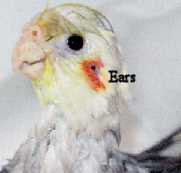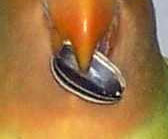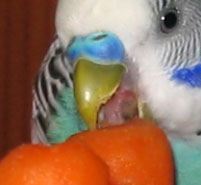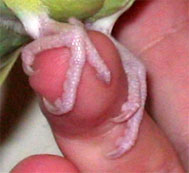General Information
Hearing

Birds have internal ears which are located on either side of their head (basically, two holes on either side of their head). In contrast, humans have external ears. A bird's ears are more evident after a bath when their plumage is wet. Birds have a very acurate sense of hearing. They can hear 400 – 20,000 Hz (humans can hear 16 to 20,000Hz) and can store sound sequences in their memory more efficiently than humans can (which is why they can mimic human speech). This large range of hearing allows them to distinguish certain calls quickly, efficiently, and accurately (which can mean the difference between life or dead upon hearing a warning call).
Taste and Smell

Birds have fewer taste buds than humans; birds have approximately 300 taste buds while humans have approximately 9,000! They can detect sweet, salty, bitter, and acidic substances. They usually prefer bitter and sour tastes over sweetness (which is why most birds prefer vegetables over fruits).
Birds do not have a well developed sense of smell, but even so, being exposed to strong odors can kill them. To give you an idea of how sensitive a bird's respiratory tract is, consider the situation in WWI when canaries were position on war front and trenches to detect chemical war fare that the enemies unleashed. The canaries would die first which served as a warning signal for soldiers to evacuate. A bird's nose is located above their beaks. In budgies, their nares are surrounded by flesh which is known as the cere.

Touch

Birds are sensitive to touch. They are sensitive to vibration (it is vital that the hen be able to sense the vibration of a chick trying to peck his way out of the egg shell upon hatching). In the wild, they use their sense of vibration to detect an approaching predator or predict rain. Because they are in tune with vibrations, if they register a vibration they are not familiar with it can cause them to get startled or panic. This is one of the leading causes for night frights. They also have specialized organs called the Herbsts corpuscles, found at the base of each feather, which allows them to detect touch (be it vibrations or the airflow over their body). Herbsts corpuscles are also located in the legs, allowing them to feel vibrations from the perch they are standing on. The beak is another tool they use for touch, this is why birds tend to mouth everything that is given to them.
Vision

Birds can see 150 images/sec (compared to 60 images/sec for humans) which is an adaptation for these fast flying creatures. Their eyes are located on the side of their head giving them panoramic vision (meaning they can see in front of them, their sides, and behind them all at the same time) which gives them a large field of vision and allow them to spot predators efficiently. Each eye can register images independently of each other.
Their eyes are globular and they can change the shape of their eyes which allows them to focus at different distances. On average, their eyes have twice the focus strength of human eyes.
A bird's eyes contain rod and cone cells on their retina which enable them to see colors. They can also see ultraviolet light (a color human eyes cannot register) and are thought to recognize their own species by detecting ultraviolet light form cheek patches (in budgies), legs, and feet.
Like human eyes, they contain a spot on their retina called the fovea. The fovea contains cone cells and allows birds to produce sharp images. Hence, when a bird tilts his head (known as "head cocking"), they are focusing the image on their fovea.
